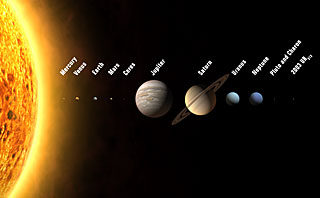Related Links
Basic Planetary DataThe Solar SystemThe Flap Over Pluto (from 1999)Sedna (from 2004)A Tenth Planet? Or just Eight? (from 2005)Naming PlutoThe Color of Pluto
“Classical” Planets
Mercury through Neptune would be described as “classical” planets; Ceres, Pluto, Charon, and 2003 UB313 have a “dwarf” description. A new category of planets, pluton (named, of course, after Pluto), is for planets that take longer than 200 years to complete an orbit around the Sun. These orbits also tend to be eccentric—far from being circular and and also have a greater orbital tilt (“inclination”) than those of the classical planets.
Double Planet
Charon would lose its satellite classification and with Pluto would be considered a “double planet.” A double planet is two bodies that have their common center of gravity (“barycenter”) between them in space and not in the interior of either planet. The barycenter of the Moon and Earth is within the Earth, not in space.
More Planets to Come?
The IAU also has a dozen candidate planets awaiting future inclusion in the solar system. Future denizens of our system could include Sedna, Orcus, Quaoar, Varuna, Ixion—all found beyond Pluto; the asteroids Vesta, Pallas, and Hygiea; and four yet unnamed bodies (2003 EL61, 2005 FY9, 2002 TX300, and 2002 AW197).
More about The Solar System
